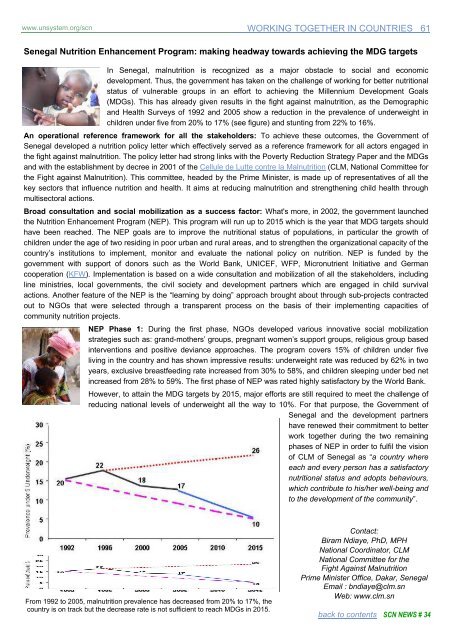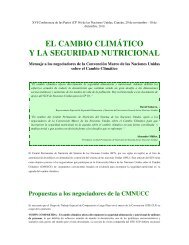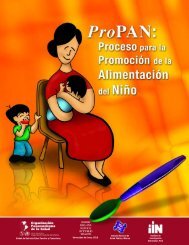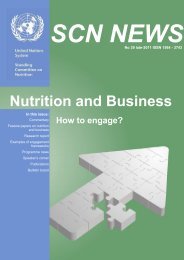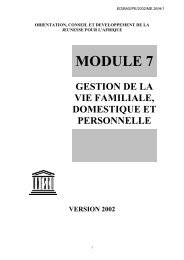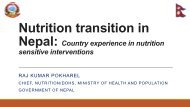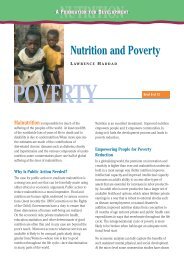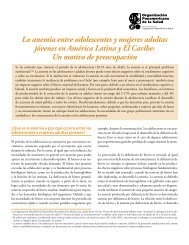SCN News No 34 - UNSCN
SCN News No 34 - UNSCN
SCN News No 34 - UNSCN
Create successful ePaper yourself
Turn your PDF publications into a flip-book with our unique Google optimized e-Paper software.
www.unsystem.org/scn WORKING TOGETHER IN COUNTRIES 61<br />
Senegal Nutrition Enhancement Program: making headway towards achieving the MDG targets<br />
In Senegal, malnutrition is recognized as a major obstacle to social and economic<br />
development. Thus, the government has taken on the challenge of working for better nutritional<br />
status of vulnerable groups in an effort to achieving the Millennium Development Goals<br />
(MDGs). This has already given results in the fight against malnutrition, as the Demographic<br />
and Health Surveys of 1992 and 2005 show a reduction in the prevalence of underweight in<br />
children under five from 20% to 17% (see figure) and stunting from 22% to 16%.<br />
An operational reference framework for all the stakeholders: To achieve these outcomes, the Government of<br />
Senegal developed a nutrition policy letter which effectively served as a reference framework for all actors engaged in<br />
the fight against malnutrition. The policy letter had strong links with the Poverty Reduction Strategy Paper and the MDGs<br />
and with the establishment by decree in 2001 of the Cellule de Lutte contre la Malnutrition (CLM, National Committee for<br />
the Fight against Malnutrition). This committee, headed by the Prime Minister, is made up of representatives of all the<br />
key sectors that influence nutrition and health. It aims at reducing malnutrition and strengthening child health through<br />
multisectoral actions.<br />
Broad consultation and social mobilization as a success factor: What's more, in 2002, the government launched<br />
the Nutrition Enhancement Program (NEP). This program will run up to 2015 which is the year that MDG targets should<br />
have been reached. The NEP goals are to improve the nutritional status of populations, in particular the growth of<br />
children under the age of two residing in poor urban and rural areas, and to strengthen the organizational capacity of the<br />
country’s institutions to implement, monitor and evaluate the national policy on nutrition. NEP is funded by the<br />
government with support of donors such as the World Bank, UNICEF, WFP, Micronutrient Initiative and German<br />
cooperation (KFW). Implementation is based on a wide consultation and mobilization of all the stakeholders, including<br />
line ministries, local governments, the civil society and development partners which are engaged in child survival<br />
actions. Another feature of the NEP is the “learning by doing” approach brought about through sub-projects contracted<br />
out to NGOs that were selected through a transparent process on the basis of their implementing capacities of<br />
community nutrition projects.<br />
NEP Phase 1: During the first phase, NGOs developed various innovative social mobilization<br />
strategies such as: grand-mothers’ groups, pregnant women’s support groups, religious group based<br />
interventions and positive deviance approaches. The program covers 15% of children under five<br />
living in the country and has shown impressive results: underweight rate was reduced by 62% in two<br />
years, exclusive breastfeeding rate increased from 30% to 58%, and children sleeping under bed net<br />
increased from 28% to 59%. The first phase of NEP was rated highly satisfactory by the World Bank.<br />
However, to attain the MDG targets by 2015, major efforts are still required to meet the challenge of<br />
reducing national levels of underweight all the way to 10%. For that purpose, the Government of<br />
Senegal and the development partners<br />
have renewed their commitment to better<br />
work together during the two remaining<br />
phases of NEP in order to fulfil the vision<br />
of CLM of Senegal as “a country where<br />
each and every person has a satisfactory<br />
nutritional status and adopts behaviours,<br />
which contribute to his/her well-being and<br />
to the development of the community”.<br />
From 1992 to 2005, malnutrition prevalence has decreased from 20% to 17%, the<br />
country is on track but the decrease rate is not sufficient to reach MDGs in 2015.<br />
Contact:<br />
Biram Ndiaye, PhD, MPH<br />
National Coordinator, CLM<br />
National Committee for the<br />
Fight Against Malnutrition<br />
Prime Minister Office, Dakar, Senegal<br />
Email : bndiaye@clm.sn<br />
Web: www.clm.sn<br />
back to contents <strong>SCN</strong> NEWS # <strong>34</strong>


